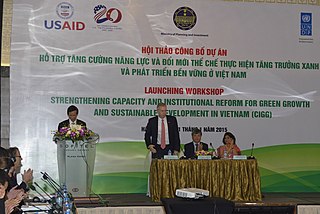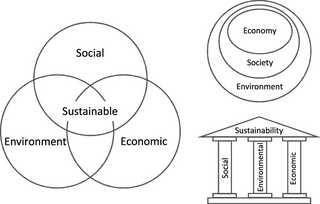Related Research Articles

Enterprise resource planning (ERP) is the integrated management of main business processes, often in real time and mediated by software and technology. ERP is usually referred to as a category of business management software—typically a suite of integrated applications—that an organization can use to collect, store, manage and interpret data from many business activities. ERP systems can be local-based or cloud-based. Cloud-based applications have grown in recent years due to the increased efficiencies arising from information being readily available from any location with Internet access.
Psychology is the study of mind and behavior. Its subject matter includes the behavior of humans and nonhumans, both conscious and unconscious phenomena, and mental processes such as thoughts, feelings, and motives. Psychology is an academic discipline of immense scope, crossing the boundaries between the natural and social sciences. Biological psychologists seek an understanding of the emergent properties of brains, linking the discipline to neuroscience. As social scientists, psychologists aim to understand the behavior of individuals and groups.
Social science is one of the branches of science, devoted to the study of societies and the relationships among individuals within those societies. The term was formerly used to refer to the field of sociology, the original "science of society", established in the 18th century. In addition to sociology, it now encompasses a wide array of academic disciplines, including anthropology, archaeology, economics, human geography, linguistics, management science, communication science, psychology and political science.
Strategy is a general plan to achieve one or more long-term or overall goals under conditions of uncertainty. In the sense of the "art of the general", which included several subsets of skills including military tactics, siegecraft, logistics etc., the term came into use in the 6th century C.E. in Eastern Roman terminology, and was translated into Western vernacular languages only in the 18th century. From then until the 20th century, the word "strategy" came to denote "a comprehensive way to try to pursue political ends, including the threat or actual use of force, in a dialectic of wills" in a military conflict, in which both adversaries interact.

A workflow is a generic term for orchestrated and repeatable patterns of activity, enabled by the systematic organization of resources into processes that transform materials, provide services, or process information. It can be depicted as a sequence of operations, the work of a person or group, the work of an organization of staff, or one or more simple or complex mechanisms.

Innovation is the practical implementation of ideas that result in the introduction of new goods or services or improvement in offering goods or services. ISO TC 279 in the standard ISO 56000:2020 defines innovation as "a new or changed entity, realizing or redistributing value". Others have different definitions; a common element in the definitions is a focus on newness, improvement, and spread of ideas or technologies.
Public policy is an institutionalized proposal or a decided set of elements like laws, regulations, guidelines, and actions to solve or address relevant and real-world problems, guided by a conception and often implemented by programs. These policies govern and include various aspects of life such as education, health care, employment, finance, economics, transportation, and all over elements of society. The implementation of public policy is known as public administration. Public policy can be considered to be the sum of a government's direct and indirect activities and has been conceptualized in a variety of ways.
Strategic planning is an organization's process of defining its strategy or direction, and making decisions on allocating its resources to attain strategic goals.

Business performance management (BPM) is a management approach which encompasses a set of processes and analytical tools to ensure that an organization's activities and output are aligned with its goals. BMP is associated with business process management, a larger framework managing organizational processes.

S.M.A.R.T. is an acronym used as a mnemonic device to establish criteria for effective goal-setting and objective development. This framework is commonly applied in various fields, including project management, employee performance management, and personal development. The term was first proposed by George T. Doran in the November 1981 issue of 'Management Review', where he advocated for setting objectives that are Specific, Measurable, Assignable, Realistic, and Time-bound—hence the acronym S.M.A.R.T.
Governance is the process of making and enforcing decisions within an organization or society. It encompasses decision-making, rule-setting, and enforcement mechanisms to guide the functioning of an organization or society. Effective governance is essential for maintaining order, achieving objectives, and addressing the needs of the community or members within the organization. Furthermore, effective governance promotes transparency, fosters trust among stakeholders, and adapts to changing circumstances, ensuring the organization or society remains responsive and resilient in achieving its goals. It is the process of interactions through the laws, social norms, power or language as structured in communication of an organized society over a social system. It is done by the government of a state, by a market, or by a network. It is the process of choosing the right course among the actors involved in a collective problem that leads to the creation, reinforcement, or reproduction of acceptable conduct and social order". In lay terms, it could be described as the processes that exist in and between formal institutions.
Interculturalism is a political movement that supports cross-cultural dialogue and challenging self-segregation tendencies within cultures. Interculturalism involves moving beyond mere passive acceptance of multiple cultures existing in a society and instead promotes dialogue and interaction between cultures. Interculturalism is often used to describe the set of relations between indigenous and western ideals, grounded in values of mutual respect.
In planning and policy, a wicked problem is a problem that is difficult or impossible to solve because of incomplete, contradictory, and changing requirements that are often difficult to recognize. It refers to an idea or problem that cannot be fixed, where there is no single solution to the problem; and "wicked" denotes resistance to resolution, rather than evil. Another definition is "a problem whose social complexity means that it has no determinable stopping point". Moreover, because of complex interdependencies, the effort to solve one aspect of a wicked problem may reveal or create other problems. Due to their complexity, wicked problems are often characterized by organized irresponsibility.
In business analysis, PEST analysis describes a framework of macro-environmental factors used in the environmental scanning component of strategic management. It is part of an external environment analysis when conducting a strategic analysis or doing market research, and gives an overview of the different macro-environmental factors to be taken into consideration. It is a strategic tool for understanding market growth or decline, business position, potential and direction for operations.
Social marketing is a marketing approach which focuses on influencing behavior with the primary goal of achieving "common good". It utilizes the elements of commercial marketing and applies them to social concepts. However, to see social marketing as only the use of standard commercial marketing practices to achieve non-commercial goals is an oversimplified view. Social marketing has existed for some time, but has only started becoming a common term in recent decades. It was originally done using newspapers and billboards and has adapted to the modern world in many of the same ways commercial marketing has. The most common use of social marketing in today's society is through social media.

Social entrepreneurship is an approach by individuals, groups, start-up companies or entrepreneurs, in which they develop, fund and implement solutions to social, cultural, or environmental issues. This concept may be applied to a wide range of organizations, which vary in size, aims, and beliefs. For-profit entrepreneurs typically measure performance using business metrics like profit, revenues and increases in stock prices. Social entrepreneurs, however, are either non-profits, or they blend for-profit goals with generating a positive "return to society". Therefore, they use different metrics. Social entrepreneurship typically attempts to further broad social, cultural and environmental goals often associated with the voluntary sector in areas such as poverty alleviation, health care and community development.

Capacity building is the improvement in an individual's or organization's facility "to produce, perform or deploy". The terms capacity building and capacity development have often been used interchangeably, although a publication by OECD-DAC stated in 2006 that capacity development was the preferable term. Since the 1950s, international organizations, governments, non-governmental organizations (NGOs) and communities use the concept of capacity building as part of "social and economic development" in national and subnational plans. The United Nations Development Programme defines itself by "capacity development" in the sense of "'how UNDP works" to fulfill its mission. The UN system applies it in almost every sector, including several of the Sustainable Development Goals to be achieved by 2030. For example, the Sustainable Development Goal 17 advocates for enhanced international support for capacity building in developing countries to support national plans to implement the 2030 Agenda.

Participatory rural appraisal (PRA) is an approach used by non-governmental organizations (NGOs) and other agencies involved in international development. The approach aims to incorporate the knowledge and opinions of rural people in the planning and management of development projects and programmes.

Sustainability is a social goal for people to co-exist on Earth over a long time. Definitions of this term are disputed and have varied with literature, context, and time. Sustainability usually has three dimensions : environmental, economic, and social. Many definitions emphasize the environmental dimension. This can include addressing key environmental problems, including climate change and biodiversity loss. The idea of sustainability can guide decisions at the global, national, and individual levels. A related concept is that of sustainable development, and the terms are often used to mean the same thing. UNESCO distinguishes the two like this: "Sustainability is often thought of as a long-term goal, while sustainable development refers to the many processes and pathways to achieve it."
Whole-of-Government Approach (“WGA”) refers to the joint activities performed by diverse ministries, public administrations and public agencies in order to provide a common solution to particular problems or issues, and involve some form of cross-boundary work and restructuring.
References
- ↑ Botti, Antonio; Monda, Antonella (15 June 2019). "Goal Ambiguity in Public Organizations: A Systematic Literature Review". International Journal of Business and Management. 14 (7): 137. doi:10.5539/IJBM.V14N7P137.
- ↑ Ritchie, Victoria F. (2014). ""UNDERSTANDING THE CONNECTIONS BETWEEN GOAL AMBIGUITY, LATERAL ORGANIZATIONAL COMMUNICAITON, AND JOB SATISFACTION"". Research Papers. Paper 541: Southern Illinois University Carbondale. Retrieved 11 May 2024.
{{cite web}}: CS1 maint: location (link) - ↑ Davis, Randall S. (2022). "Goal-Setting Theory of Organizations". Global Encyclopedia of Public Administration, Public Policy, and Governance: 5626–5630. doi:10.1007/978-3-030-66252-3_160.
- ↑ Open Government: Concepts, Methodologies, Tools, and Applications: Concepts, Methodologies, Tools, and Applications. IGI Global. 6 September 2019. p. 275-276. ISBN 978-1-5225-9861-9.
- ↑ Durant, Robert F. (2 August 2012). The Oxford Handbook of American Bureaucracy. Defining Goal Ambiguity: OUP Oxford. pp. 238–240. ISBN 978-0-19-162832-0 . Retrieved 11 May 2024.
- ↑ Thompson, Derek (8 May 2024). "No One Knows What Universities Are For". The Atlantic. Retrieved 11 May 2024.